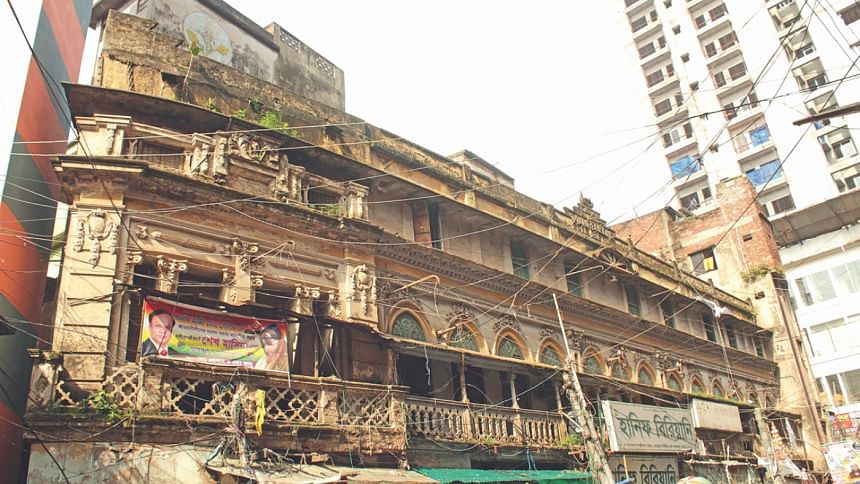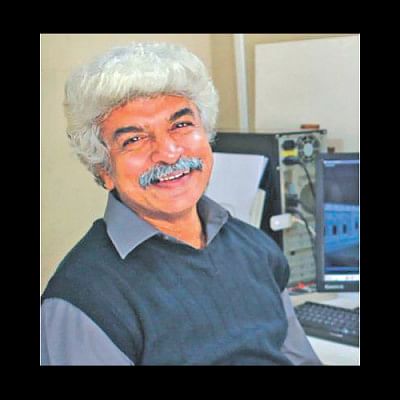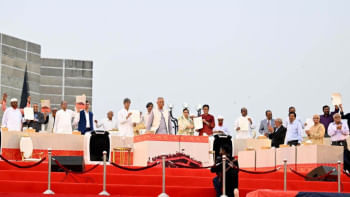Living like there is no past

Leading heritage activist of the country Taimur Islam talks to Kazi Nafisa Hasan of The Daily Star about the woeful status of heritage sites in Old Dhaka and the challenges of preserving them.

"It looked like a war zone! The century-old three-storey structure was bulldozed to the ground overnight!" Taimur Islam refers to Jahaj Bari in Old Dhaka which was demolished recently in the presence of the local lawmaker. The Member of Parliament claims ownership of the heritage site which is also waqf property.
This is a case of unbound greed and sheer disrespect for law, laments Taimur. The High Court Judgement (writ#4656 of 2018) directed the relevant government authorities including Rajuk and Department of Archaeology to preserve Jahaj Bari along with 2,199 other buildings of Old Dhaka as heritage sites and "not to approve or allow construction of buildings in any of the sites."
Taimur informs that earlier on March 29, 2019 they filed a GD (general diary) at the Chawkbazar police station after learning about an attempt at demolishing the Jahaj Bari. The Waqf Board also served notices to the local police station and Rajuk. These efforts had preempted the demolition plan at that time but couldn't save the structure in the end. Taimur urges that this incident should be a wakeup call if we really want to protect the existing heritage sites in Old Dhaka—most of which are now under the threat of extinction.
The tag of heritage site on their property becomes a burden for the lawful owners. As per law, they can't sell the land or utilise it for constructing high-rises. Unfortunately, the government also doesn't provide any compensation to them.
Urban Study Group (USG), founded by Taimur Islam, prepared a comprehensive list of 2,200 buildings in Old Dhaka that need to be protected as heritage sites. The buildings were enlisted in three categories. Grade 01 buildings are the ones which have very special significance and efforts should be made to preserve as much of the structure as possible. Jahaj Bari belonged to this grade. In case of Grade 02 buildings, the significant parts of the interior should be preserved along with the façade, and in Grade 03 buildings, only the historic façade should be retained while the rest of the building can be disposed of.

It's also important to note that not every building has been enlisted according to its individual significance as a heritage property, Taimur opines. In fact, a large share of the buildings was included for their group value, especially due to their contribution to the historic streetscape. He draws the example of BK Das Road of Puran Dhaka. BK Das Road was named after Bashanta Kumar Das as a tribute to a renowned philanthropist of Dhaka. The buildings along the street were mostly built around the early 1900s. Since they stand in a cluster, their aesthetic and historical values are interdependent. The destruction of one single building in the row will affect the total ambience of the street, explains the heritage expert.
USG has developed the restoration plan of this street with graphic details which show how the whole area can be transformed into a cultural hub keeping the structures intact [see image].
Talking about the challenges of protecting these heritage sites, Taimur highlights the stake of property owners. The tag of heritage site on their property becomes a burden for the lawful owners. As per law, they can't sell the land or utilise it for constructing high-rises. Unfortunately, the government also doesn't provide any compensation to them. To resolve this problem, the expert suggests that the government should adopt TDR (Transfer of Development Rights) policies in an efficient manner. Under this policy, the property owner can sell his development right to any third party and that party can develop buildings somewhere else. The whole process has to be thoroughly monitored and regulated by the responsible government authority, adds Taimur.

He further recommends that the government could initially launch a pilot programme for 50 heritage buildings, provide compensations to the property owners and carry out the restoration work. Drawing on the example of Mumbai, Taimur informs that the Mumbai government has successfully implemented TDR to preserve heritage in the marine drive area, which has now become a major attraction for locals as well as Mumbai-bound-tourists.
The listing procedure of heritage sites is also faulty, identifies Taimur. Proper listing is a vital part of the whole process of preservation as it works like a map in identifying the sites and helps in the understanding of the level of protection and restoration required.
Taimur provides a brief history of listing attempts in support of his observation. Earlier the national list of the Department of Archaeology had included only around 37 heritage sites in Dhaka city. After years of campaigning for revision of the list, a separate heritage list was published on February 12, 2009. Although the gazette was published by Rajuk, the list was actually prepared by the first heritage committee of the city formed in 2008 by the Urban Development Committee.

The heritage committee was told that the listing process was going to be a continuous one; the buildings and sites which weren't included in the preliminary list would be enlisted gradually. But there was no progress at all. In 2011 several attempts were made to demolish a number of buildings in Old Dhaka. USG resorted to the only alternative available: a number of writ petitions were filed at the High Court.
Then in 2012 while the District Council Building was being demolished, USG filed another writ petition (#12787 of 2012). The honourable judges issued a direction to the government to prepare a complete heritage list for Dhaka city based on USG's list and a report was supposed to be submitted to the court by the concerned departments within three months of passing the order.
But over the next 2-3 years, neither Rajuk nor the Department of Archaeology took any steps in this regard. Another Heritage Committee was formed in 2014. The Listing Committee which was formed by the Heritage Committee worked through 2015 and 2016. In 2016 they compiled a draft heritage list, based on the list submitted by USG. While the work was in progress, USG continued to survey those areas, which were not covered in the previous list, e.g. Gandaria, Hazaribagh, Faridabad, Swamibag, etc. By December 2017 when the list was submitted to the government, there was an increase in the number of buildings. Actually, the total number of buildings could go up to 2,700 or a little more than that. To confirm this USG needed a little more time but the final hearing of the writ took place within such a short time after the filing of the petition that it was not possible to further verify the sites.

Another big challenge, adds Taimur, is the weak enforcement of existing laws regarding protection of heritage sites. He explains that on April 2, 2018, after a preliminary hearing on the writ (#4656 of 2018) filed by USG, the honourable judges of the High Court passed an order directing the Secretary, Ministry of Housing and Public Works; Secretary, Ministry of Cultural Affairs; DG Department of Archaeology; and Rajuk to submit a report within three months to the court which would include a historic assessment of the buildings included in the list. The latter order, effectively, provided protection to all of the buildings listed by USG.
So far, neither has the archaeological department submitted any report to the court nor has Rajuk refrained from giving permission for new construction in the place of USG-listed buildings.
Then on August 13, 2018, after the full hearing of the above-mentioned writ petition (#4656 of 2018), the High Court passed the final verdict, giving blanket protection for all the 2,200 buildings included in the USG's list.
In the verdict, the honourable judges directed the DG, Department of Archaeology of the Ministry of Cultural Affairs, "to take appropriate steps under Section 3 of the Antiquities Act, 1968 by examining the list of buildings submitted by the petitioner for ascertaining their historical importance and report compliance to this Court about the progress every three months as a continuous mandamus." And in the same verdict Rajuk was separately directed "not to approve or allow construction of building in any of the sites covered in the aforesaid list of 2,200 buildings."
So far, neither has the archaeological department submitted any report to the court nor has Rajuk refrained from giving permission for new construction in the place of USG-listed buildings. At least in half a dozen cases, new construction is in progress now. USG has submitted a few petitions to Rajuk citing the court verdict but so far, they chose to ignore all the petitions, laments Taimur.
Due to the slackness in the implementation of heritage laws, over the last few months, several attempts were made to demolish quite a few buildings. A few buildings were saved with the help of the local police stations and untiring efforts of USG volunteers. In some cases, the police have stopped the demolition of the old buildings, but then in quite a few cases, they have allowed the demolition to continue, which has had a negative impact on the community, informs Taimur.
He also points out the conflict between Rajuk and Department of Archaeology. According to the Constitution and the rules of business, preservation of cultural heritages is the responsibility of the cultural ministry. Under the Antiquities Act, 1968 this responsibility has been given to the Department of Archaeology. Rajuk doesn't have any mandate to prepare a heritage list. But the 2017 heritage list was published by Rajuk. However, Rajuk, as the principal regulatory body of the city, is supposed to prepare a list of the heritage sites (prepared by Department of Archaeology) to ensure their protection. Due to the lack of coordination between the important government bodies, some very important heritage sites like Choto Katra or even Boro Katra are facing destruction. The failure of Rajuk to apply the buffer zone rule will have a serious negative impact on these two monuments, opines the expert.
Taimur further claims that improper city planning is resulting in the increase in population density which is a major threat to the preservation of heritage sites. The government, he suggests, should try to adopt decentralisation policies in order to reduce pressure on certain areas of the city such as Old Dhaka. He urges that proper utilisation of spaces be ensured in neighbouring areas of Dhaka such as Narayanganj and Gazipur. He believes that proper planning will allow a more spacious environment and lead to improved living standards for the citizens. It will also be beneficial for heritage sites.
On the immediate action plan for the protection of heritage sites in Old Dhaka, Taimur recommends that the government should select a few places in Old Dhaka and begin the restoration activities over there. Through the process of restoration, the government can turn the crowded and backward parts of the city into a cultural hub. It needs to be ensured that the structure and design of the buildings are kept intact. The process will allow the buildings or the selected zone to see a rise in their economic value.
Drawing on the example of Hanoi, Vietnam's capital, he says that the authorities in Hanoi aim at preserving every heritage monument that they believe will create a positive impact on the lifestyle of today's generation. They put the tag of "heritage" on sites on the basis of cultural significance. This results in the increase of both economic and cultural value of heritage space in Hanoi.
He also cites the example of Singapore which, despite being small in size, has succeeded in protecting its history and keeping its heritage intact. Singapore has succeeded in preserving the first mosque in the country called the Sultan Mosque which was built in 1824. The city has also preserved other old and significant historical sites such as Battle Box, a former WWII British underground command centre at the heart of Singapore city. Although Dhaka has a much wider geographic space than that of Singapore, the city is failing to save its heritage potential, laments the heritage activist.
Amidst such a bleak reality, Taimur shares, there are some successful cases of preservation that can inspire us. In 2008, the campaign "Save Puran Dhaka" reached new heights, when the campaign for Boro Bari in Farashganj saw some of the leading civil society members join in and it was given extensive coverage by the media. The government finally formed a Heritage Committee. It was also a result of the petition submitted by USG to the Nagar Unnayon Committee, which included the idea of compensation for property owners.
In 2015, as a reflection of the growing interest of the international community in heritage buildings in Puran Dhaka, Alliance Française and Goethe Institute in Dhaka came forward to organise an illumination project in Puran Dhaka. The project received massive publicity.
Taimur concludes with the hope that if the heritage sites in Old Dhaka were to be preserved properly, it would breathe fresh air into the congested, chaotic and depressed city life in Dhaka. It would make this 400-year-old city liveable again.

 For all latest news, follow The Daily Star's Google News channel.
For all latest news, follow The Daily Star's Google News channel. 



Comments